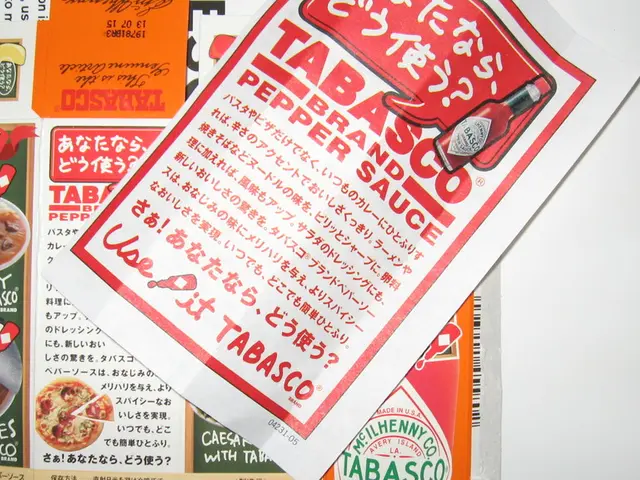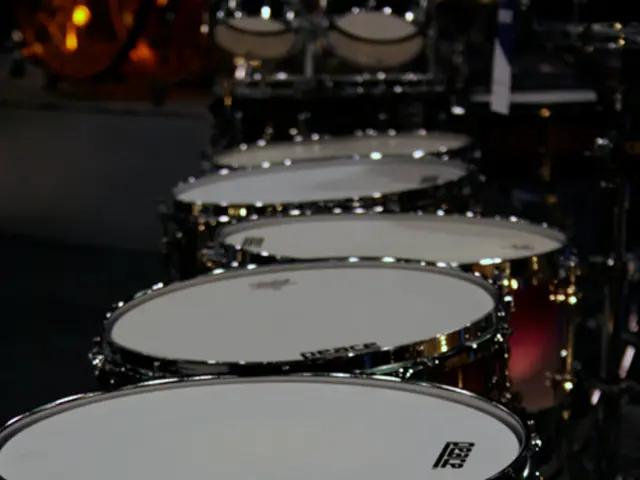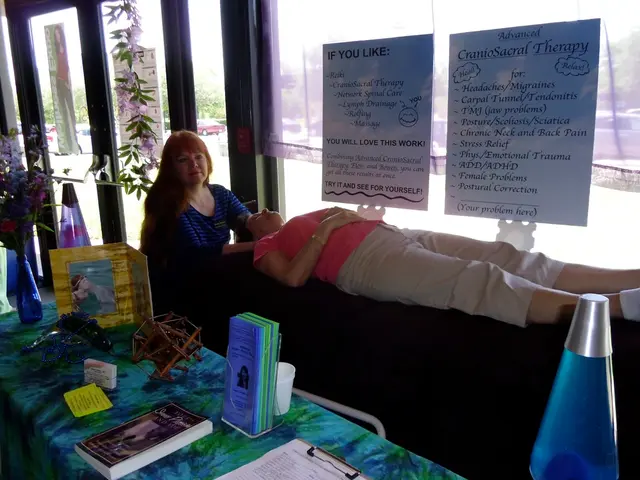Pressure Points for Relieving Pain through Acupressure
Acupressure, an ancient healing technique originating from China, is gaining popularity as a cost-effective and non-invasive approach to pain relief and managing various health conditions. This technique involves applying pressure to specific acupoints throughout the body, each corresponding to a different part.
One such pressure point, the Hegu (LI4), located between the thumb and index finger, is widely used to reduce general pain, including headaches and backaches. Stimulating this point can also relieve feelings of stress [1][5]. The Feng Chi pressure points, found on either side of the spine at the base of the skull, are effective in reducing lower back pain, while the Jianjing pressure points on the top of the shoulders can help alleviate neck stiffness and pain [2].
The temples contain the Tai Yang pressure points. Massaging the center of the temples activates these points, which can help treat headache pain from migraine attacks and decrease dizziness. The yin tang pressure point, between the eyebrows in the center of the forehead, can help relieve anxiety and tension in the eyes, head, and face [1].
Acupressure can lead to chemical effects on the body, such as reducing levels of the stress hormone cortisol and increasing the flow of endorphins to the brain, which can relieve stress and enhance blood flow. It can also improve circulation, muscle relaxation, and stimulate endorphins, all of which contribute to pain relief [4].
For individuals interested in learning more about acupressure, certified acupressure practitioners can be found through the directory of the National Certification Commission for Acupuncture and Oriental Medicine (NCCAOM) website. Commonly used pressure points for pain relief include the Kidney Shu Point (B23), located on the lower back, which helps alleviate lower back stiffness and fatigue, and the Huantiao (GB30) point, located at the midpoint between the top of the hip and the base of the buttock, which eases sciatica-related pain [2].
It is important to note that acupressure should not be used on injured or inflamed skin, scars and rashes, after eating, taking narcotics, or drinking alcohol. Acupressure may not be appropriate for pregnant individuals. Always consult a healthcare professional before starting any new treatment, including acupressure [5].
Research has found that acupressure can decrease pain intensity among individuals with cancer, making it a promising alternative treatment option [6]. With proper location and technique, acupressure can be integrated into a holistic wellness routine alongside lifestyle factors such as exercise and sleep [5].
References:
[1] "Acupressure for Headaches." Mayo Clinic, Mayo Foundation for Medical Education and Research, 15 Dec. 2020, www.mayoclinic.org/diseases-conditions/headache/in-depth/acupressure/art-20047720.
[2] "Acupressure Points for Pain Relief." Healthline, Healthline Media, 24 Oct. 2019, www.healthline.com/health/acupressure-points-for-pain-relief.
[3] "Acupressure for Neck and Shoulder Pain." WebMD, WebMD, 16 Jan. 2020, www.webmd.com/pain-management/acupressure-for-neck-and-shoulder-pain#1.
[4] "Acupressure: Techniques, Benefits, and Points." Medical News Today, MediLexicon International, 12 Jan. 2021, www.medicalnewstoday.com/articles/324172.
[5] "Acupressure: Uses, Side Effects, Interactions, Dosage, and Warning." WebMD, WebMD, 11 Jan. 2021, www.webmd.com/vitamins/ai/ingredientmono-928/acupressure.
[6] "Acupressure for Cancer Pain." Cancer.net, American Society of Clinical Oncology, 12 June 2017, www.cancer.net/navigating-cancer-care/complementary-alternative-therapies/acupressure/acupressure-cancer-pain.
- Acupressure, known for alleviating pain and managing health conditions, can decrease pain intensity in individuals with conditions like diabetes, obesity, and COPD, due to its effect on the body's chemicals.
- The use of acupressure therapies and treatments can help reduce symptoms associated with depression, stress, and anxiety, making it a valuable addition to mental health care.
- The Jianjing pressure points, located on the top of the shoulders, can help alleviate not only neck stiffness and pain but also symptoms of conditions such as asthma and ulcerative colitis.
- The yin tang pressure point, promoting relaxation and relief from tension, may lead to benefits for individuals dealing with psoriasis, a common skin condition.
- By increasing endorphins flow, acupressure can help manage headaches and migraines, alongside conventional treatments like medication.
- The Feng Chi pressure points, found at the base of the skull, are known to offer relief from conditions like diabetes, headache, and type 2 diabetes, in addition to alleviating lower back pain.
- Research shows that proper application of acupressure can lead to reduced symptoms for various health issues, as demonstrated by the improvement in health-and-wellness observed in individuals dealing with obesity, colitis, and diabetes.
- With its potential to serve as a cost-effective, non-invasive, and complementary approach to pain management, acupressure and its various points, such as the Huantiao (GB30) and Kidney Shu Point (B23), hold promise for individuals seeking alternative treatment options for conditions like back pain, sciatica, and lower back stiffness.




